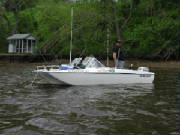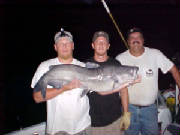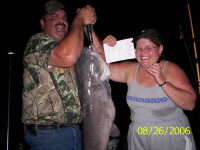HOME MADE FISH OIL
Guys for years in the trapping industry the fish oil was home made, it was just too expensive to
buy from a supply store, in the old days when it first hit the market it was in the area of 10.00 an ounce and a half, we
made ours for trapping fox and coon and even skunks, it is a very simple process and one anyone can do. all you need is rough
fish (carp, bullheads, shad, herring, and the like) a 5 gal. bucket, cheese cloth or very fine screen.
Cut the fish
in chunks, (best done inside as you will see later) then drop them in the bucket, cover TIGHTLY with cheese cloth or screen,
( the thing here is to keep ALL bugs out you don't want any flies or bugs in the mix as they will cause spoilage) set the
bucket in the sun for a few days, you will see a foam or froth come up on the top. this is natural and is exactly what you
want to happen. when the foam appears it is time to stir the mix, take the screen off and mix well. make sure no flies or
bugs get in the mix. recover with the screen and let set again. the foam will rebuild and then die off. when the foam dissipate
then you are left with pure fish oil on the top of your mush. skim this off with a spoon and seal it in a GLASS container
with a tight lid. this will keep for a month or two as is and for up to 6 months in the fridge. the key is to keep all the
critters out so it does not spoil. this way the oil is not eaten by the bacteria from the bugs leaving their droppings and
flies laying eggs in it. if you keep all the critters out then you will have the finest bait attractant there is.
also
the higher the temps and the rougher the fish the faster the process. carp will only take three or four days where gills will
take over a week. the fish should be native to you so don't go to the store and buy a few pounds of fish and try this. The
process they use on store bought fish removes most of the natural oils and will not allow the oil to come up in the bucket.
Most catfish anglers run their water too fast to really find the good spots. Sure going out for a couple hours to kill
off some time on a Saturday afternoon with the family you are going to run to a spot you know has fish. BUT......there are
the times you need to slow things down and really look at the water. Most catfish will hold to some type of structure and
that structure will move. The tree top that was on the edge of the cut bank has moved after the flood came last fall. The
old boat that sunk when your grand pappy was a boy has moved when the current changed in that stretch of river. Things like
this are always moving around and shifting. Also the holes you fish are not the only holes in the river or lake that hold
fish. Slow things down and take a day and ride the water and look at the fish finder. You will be surprised at the things
you will find. Once found slow down even more. Look and "read" the hole. Go slow across it several times and really see the
outline, you might find a big rock or old tree top hung up in the hole that you can set up. This is why most pro fishermen
of any kind pre-fish a body of water before the tournament, so as to locate the most productive spots and to get to know the
water before crunch time.
Now that you have found a new hole or just really figured out your favorite hole, don’t run up on it on full plane
and stop right over the spot you want to set up. This will disturb the fish laying in the hole, especially if it’s a
shallow hole. Slow down a ways before the hole and idle to your spot. With the technology we have today we can pinpoint out
fishing holes to with in 10 feet on any body of water and go back to that same spot over and over. This is good but how you
approach the spot makes all the difference. When motoring over a hole you will churn up the water and if this is a lazy fish
hole then ol’ Mr. Whiskers will just move away from your noise. Just like you do with a loud radio, if you can’t
turn it down you just move, same concept here. So just remember that you make or brake the hole by your actions over and around
it.
| setting the hole for maximum coverage |

|
| there are 12 rods on this rig |
Swift current anchoring
The main problem I have when setting up a hole in the swift tide flows of the James river is keeping the boat from drifting
side to side in the current, I have looked for a long time for a solution to this, I think I found it. I use the standard
anchor off the bow with a long line played out to get a good grip. then if needed I deploy the drift bucket...............yes
a bucket, after seeing this on another site on river fishing I thought I'd try it. I took a 7 gallon bucket and removed the
handle, I drilled 4 3/8 holes down from the top about 2 inches across from each other. I then used a hole saw to drill a 2
inch hole in the center of the bottom and 4 1 inch holes around the sides about 2 inches up from the bottom. then two 12 foot
long 3/8 rope sections are tied to the bucket in the holes at the top, knot on the outside of the bucket. forming a cross
in the lines, tie an overhand knot to the end to form a small loop to attach a clip shackle. this will then give you the "yoke"
for the bucket, then clip on a rope to the shackle and tie to a cleat on the back of the boat behind the motor. the bucket
will fill with water and steady the boat in the current and keep it from drifting side to side, do not play it too far back
as it too will then drift in the current, keep it close, about 5 feet back, this way it catches the hydraulics from the motor
wash and uses the added force from it to help overcome the force of the current.
 |
 |
- Anglers not taking care of their equipment: check the line after every trip, change it at least once a year. Do proper
maintance to the reel and rod, clean them after every trip, a simple washing off in the shower or with a garden hose is all
that is needed, have the reel cleaned and lubed once a year. LOOSEN THE DRAG!! when storing the reels. this will releave the
stress on the drag system and make it last longer
- Use the best equipment you can afford, it don't need to be expencive but it can if you let it. there is alot of off
brand equipment out there that works just as well as name brand, be picky but not so picky you need a home loan to buy your
gear. If you need options then just ask. I check the wal-mart every week for deals. and with some tricking out the reels are
fine and the berkley big cat rods there are cheep and do really well
- Go slow and don't try to be superman. you can't use brute force on these big catfish, that is why good equipment plays
such a big part. set your drag and then fight the fish don't force it.

Most anglers I know really don’t know how to set their reel drags for proper performance. For a easy way to set your
drags you will need a spring scale (no need to brake the bank on this item, a simple scale from Wal-mart will due) your rod
and reel and a way to hold the rod, I use the rod holder on my boat to do this since that is where they will be when I need
the drag set properly. The main thing you must know is the line strength. The pound test rating of the line is what you use
to set your drag. The amount of line on the spool also decides how and where to set the drag. Optimum results can only be
achieved when all the physical factors have been met. I will use easy round number to explain this but all that is needed
is to divide the reel into 4ths. 1/4 spool, 1/2spool, 3/4spool, and full spool. I will use a line rating of 50 lb. Test for
this example. With a full spool of line pull off about 20 feet through the guides and then tie a swivel to the end. Put the
rod in a sturdy holder, hook the scale to the swivel and pull till the drag slips, read the poundage on the scale. For a line
rating of 50 pounds this reading should be 12.5 pounds. Now when the spool is down to ½, the drag will be set at 25 pounds,
and when the spool is down to 1/4 full it will be set at 37.5 pounds and when it reached the knot at the spool it will be
at 50 pounds. The original setting will take some trial and error till you get the hang and feel of it but this is the way
offshore charter boats and guides set their drag settings on their reels. I learned it from a charter boat captain that showed
me several big fish setups and rigs. However this is the one thing he stressed the most. With out a proper drag setting your
trophy fish is all but lost before it ever takes the bait. The drag setting is the one thing that will land a fish regardless
of the quality of your equipment. Too tight and the fish brakes the line and too loose the fish runs off all the line. The
drag is the fine gray line between the trophy fish in the pictures and the discussed angler sitting on the boat talking to
him self.

Pros secret leader tip
Use Dacron line in the 30 to 100 pound test class for your leader line. It allows more movement of the bait in the current
and is less detectable to the fish when attacking the bait before taking it all the way.
|
 |
 |